ARTISTS
Looking for Nick Salumer
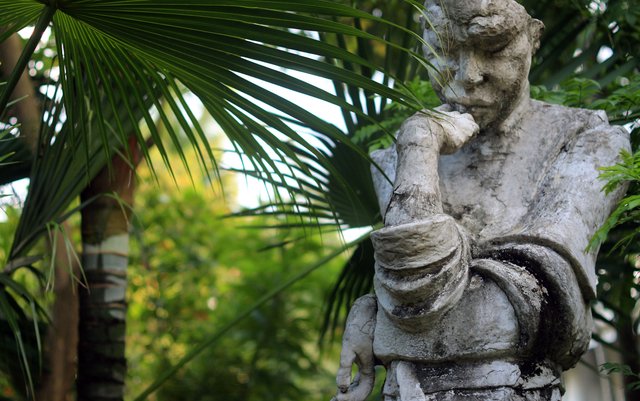 I start this story with Nick Salumer because I can still picture him in my head: black leathery skin like magkuno polished by harsh wind and sun. Muscular, like a fully matured little man though he was only a child. Deep set eyes, and a quality of mind I found quite intriguing. There I was, a child beginning a life that would take me away from here. There he was, living where he would spend the rest of his life. I met him again just a few years ago. And I found it hard to talk to him, not just because he had become hard at hearing but also because I could not speak our language, Binisaya, with the same easy comfort I used to feel.
I start this story with Nick Salumer because I can still picture him in my head: black leathery skin like magkuno polished by harsh wind and sun. Muscular, like a fully matured little man though he was only a child. Deep set eyes, and a quality of mind I found quite intriguing. There I was, a child beginning a life that would take me away from here. There he was, living where he would spend the rest of his life. I met him again just a few years ago. And I found it hard to talk to him, not just because he had become hard at hearing but also because I could not speak our language, Binisaya, with the same easy comfort I used to feel.
Nick’s second name is rooted in the Binisaya “salum,” or in the city “saum,” which word means “to dive underwater.” He was a diver. But the “er” antecedent is English form. His name is an uncanny mix quite typical of the language or languages of the place. The older upper class spoke a form of Spanish. The generations after them spoke or studied to speak American English. I lost my Binisaya over time. And I am only now beginning to regain it.
Raymund L. Fernandez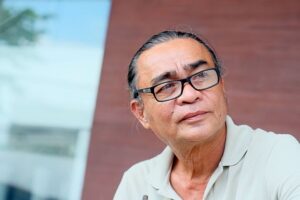 Raymund L. Fernandez was born in Dumanjug, Cebu, on May 9, 1955. He is married to Estela Ocampo-Fernandez and has three children: Isagani Isla, Linya Julia, and Elias Leon. He studied in Sacred Heart School for Boys until 1972 when he graduated High School. He took two years of Mechanical Engineering in the University of San Carlos, Cebu City. He transferred to the Fine Arts Program of the University of the Philippines College Cebu in 1976. He graduated in 1982 with a Bachelor of Fine Arts degree. He worked as a free-lance journalist for various magazines in Cebu and the Hong Kong based Union of Catholic Asia News (UCAN). He was Creative Director for the design studio. Patikgrafik, which he partially owned. He started teaching as a Lecturer of the UP Cebu College Fine Arts Program teaching Photography and other art courses. He became a full time Professor until May, 2020, when he retired.
Raymund L. Fernandez was born in Dumanjug, Cebu, on May 9, 1955. He is married to Estela Ocampo-Fernandez and has three children: Isagani Isla, Linya Julia, and Elias Leon. He studied in Sacred Heart School for Boys until 1972 when he graduated High School. He took two years of Mechanical Engineering in the University of San Carlos, Cebu City. He transferred to the Fine Arts Program of the University of the Philippines College Cebu in 1976. He graduated in 1982 with a Bachelor of Fine Arts degree. He worked as a free-lance journalist for various magazines in Cebu and the Hong Kong based Union of Catholic Asia News (UCAN). He was Creative Director for the design studio. Patikgrafik, which he partially owned. He started teaching as a Lecturer of the UP Cebu College Fine Arts Program teaching Photography and other art courses. He became a full time Professor until May, 2020, when he retired.
He has a rich body of works in painting, sculpture and performance. His works of monumental art include: “Tugpo,” once at Ayala Mall; “Icarus and Daedalus” at the Print Town building “ASEAN Friendship Grove,” at Family Park; “Jesuit Encounters an Angel,” at Ateneo Cebu campus; and others.
Fernandez has performed with xo?, a performance art group with the late Winston Velez, the late Oliver Seville, Russ Ligtas, Chai Fonacier, Greys Compuesto, among others.
Fernandez carves wood, and has specialized skills in welding and soldering metals, especially steel and copper. His body of works include metal sculpture of various sizes.
Binanog Dance. 2021. Acrylic on canvas. 20x15 inches
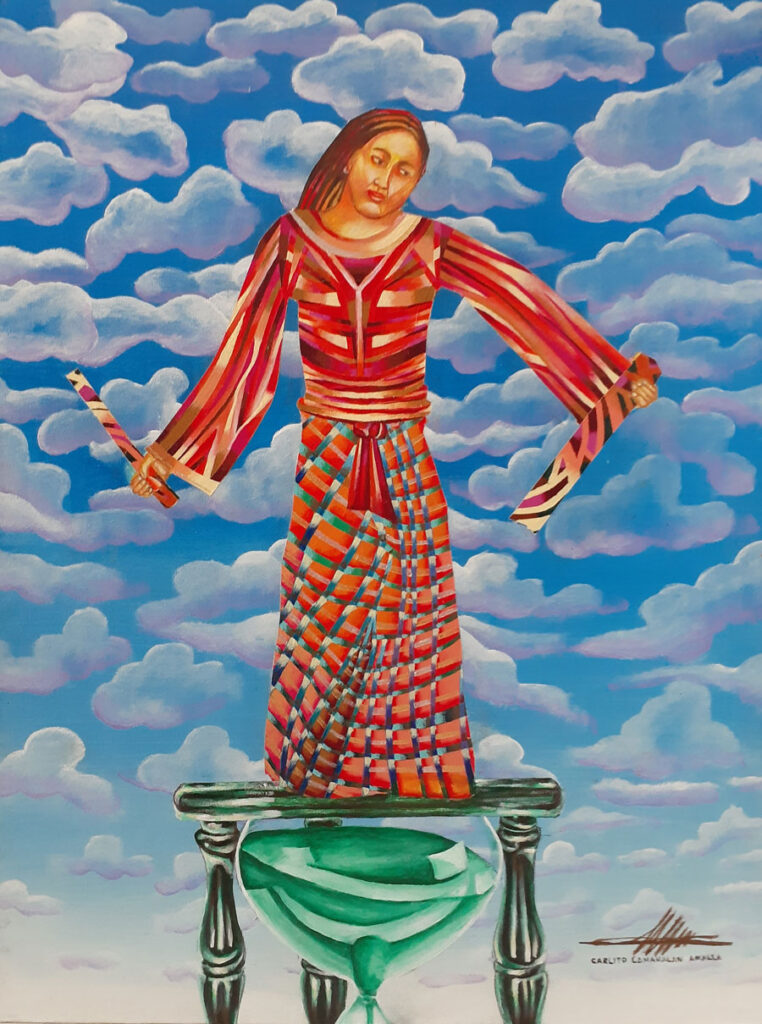
The Panay-Bukidon dances such as the”Binanog” is an eagle dance. Philippine is animal winged country, dance showcasing birds imitation. It mimics the movement of high-flying hawk or bird in narrative. It is an animal on air. “Inamo” is a monkey dance. One of the favourite’s animal is monkey. Iconography of agitated and energetic monkey. It imitates movement from real animals in nature. It is an animal on land. Dances have untainted by Spanish and American influences. The princess is Binokot or ‘’wrapped up,” reserved for an appropriate marriage. Inspired by animistic belief and shamanistic leadership. Imitative dances both are symbolic, ritualistic and dynamic. Dance art is to record their ideas and feelings as they performed. Dance with their feet close to the ground. It stands in hour glass as nostalgia. Glass hour is the emblem that human existence is fleeting, and the sands of time will run out for every human life. It tells that this dance heritage is vanishing. The background of clouds is an emblem of mystery, fantasy, and melancholy. The works are at once an expression of his personal sensibilities and an embodiment of the multi-faceted character of Filipino culture. In such experience, the local has amalgamated with the cosmopolitan, and it is this harmonious synthesis that defines much of his artistic output. A parallelism can be drawn with Philippine art and culture, in which the indigenous deeply rooted in local life and reality has been layered and enriched with influences coming from the outside, thus giving Philippine art its link with world art, and its ability to converse in an international dialogue. These works embody the vitality of local customs and traditions, a vitality that allows them to lend themselves easily to the spectrum of artistic languages. Represented in distilled form, the complex, hybrid, and multi-layered Filipino art and culture exhibit a kaleidoscopic diversity bursting of energy and dynamism.
Carlito Camahalan Amalla
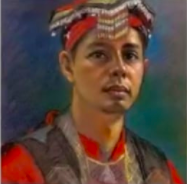 Carlito Camahalan Amalla is a true blooded member of the Agusanon Manobo tribe and currently an Assistant Professor at the De La Salle-College of St. Benilde School of Design and Arts. He is a visual artist, performer, puppeteer, dancer, chanter, musician, ceramist and researcher. He is the recipient of the 2021 Asia Pacific Luminare Award, 2020 Outstanding Leadership in Culture and the Arts in New York City, 2016 University of the Philippines Alumni Association-Distinguished Alumnus in Community Empowerment, 2015 The Outstanding Butuanon Award, 2012 Gat Apolinario Mabini Award, 2009 United Nations Outstanding Youth Service Award, 2008 National Outstanding Volunteer Award.Carlito is presently a Board of Trustees of the International Honor Society of Phi Kappa Phi Chapter 045 University of the Philippines. He is the founder and leader of the Agusan Artists Association in Butuan City and Balangay Artists Association in Manila. He had art exhibitions in Wales, Gent, London, New York and solo art exhibits at the UP Vargas Museum. He is cultural ambassador in North America, Asia and Europe. He holds a Bachelor degree of Fine Arts major in Sculpture and a Master’s degree in Art History at the University of the Philippines. His Agusan Manobo Embroidery Art thesis, paintings and puppetry in Awit ni Baylan was part of the Mindanao: Cartography of History, Identity and Representation at the SOAS University of London in 2019. His Master thesis was featured in the Cultural Center of the Philippines Encyclopedia of Philippine Art.
Carlito Camahalan Amalla is a true blooded member of the Agusanon Manobo tribe and currently an Assistant Professor at the De La Salle-College of St. Benilde School of Design and Arts. He is a visual artist, performer, puppeteer, dancer, chanter, musician, ceramist and researcher. He is the recipient of the 2021 Asia Pacific Luminare Award, 2020 Outstanding Leadership in Culture and the Arts in New York City, 2016 University of the Philippines Alumni Association-Distinguished Alumnus in Community Empowerment, 2015 The Outstanding Butuanon Award, 2012 Gat Apolinario Mabini Award, 2009 United Nations Outstanding Youth Service Award, 2008 National Outstanding Volunteer Award.Carlito is presently a Board of Trustees of the International Honor Society of Phi Kappa Phi Chapter 045 University of the Philippines. He is the founder and leader of the Agusan Artists Association in Butuan City and Balangay Artists Association in Manila. He had art exhibitions in Wales, Gent, London, New York and solo art exhibits at the UP Vargas Museum. He is cultural ambassador in North America, Asia and Europe. He holds a Bachelor degree of Fine Arts major in Sculpture and a Master’s degree in Art History at the University of the Philippines. His Agusan Manobo Embroidery Art thesis, paintings and puppetry in Awit ni Baylan was part of the Mindanao: Cartography of History, Identity and Representation at the SOAS University of London in 2019. His Master thesis was featured in the Cultural Center of the Philippines Encyclopedia of Philippine Art.
The UPCIS Bunraku Ensemble's Si Felimon, A Bunraku Puppet Dance Directed by Dr. Jina Umali
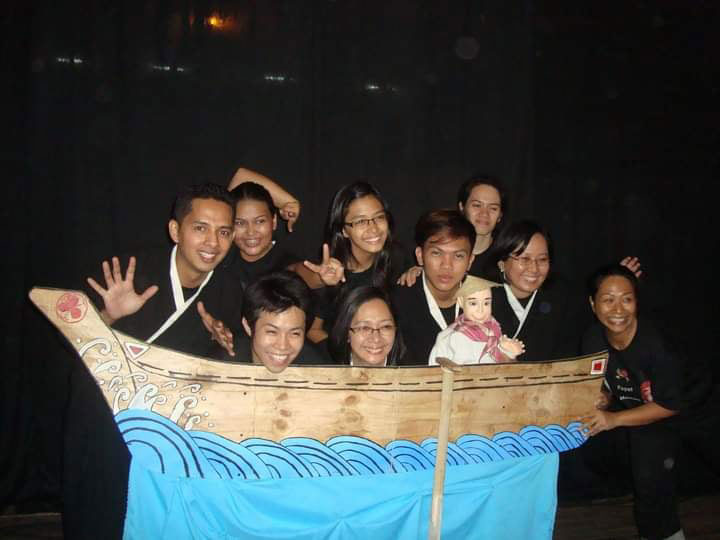
The UPCIS Bunraku Ensemble or The University of the Philippines Center for International Studies (UPCIS) Bunraku Ensemble is composed of students, alumni, faculty, professional artists, theater enthusiasts and practitioners with keen interest in the art of Bunraku – a Japanese puppetry tradition performed by 3 ningyo tsukai or puppeteers, a shamisen player and a joruri chanter. The Ensemble’s original members — Profs. Amihan Ramolete, Aileen dela Cruz, Carlito Amalla (ningyo tsukai), Ms. Jo-Anne Quiros (joruri), and Ms. Gian Gianan (shamisen) — travelled to Naoshima, Kagawa Prefecture in 2012 for an intensive-training rehearsal with Mr. Bunji Yoshida, a master puppeteer from the National Bunraku Theater of Japan and the Naoshima Onna Bunraku. Since then, the ensemble has welcomed students of Japan Studies and Japanese Traditional Performance Practice classes offered at the UPCIS who train on the Bunraku. Students who pass the JASSO Short Stay Visit selection process travel to Japan to participate in a student exchange program with Yokohama National University and Ferris University and train with the Naoshima Onna Bunraku. The ensemble’s adviser is Amparo Adelina C. Umali, III, Ph.D. of UPCIS. Si Felimon, A Bunraku Dance features Aileen dela Cruz as head puppeteer, Carlito Camahalan Amalla, as left hand puppeteer, Ma. Fe Lafuente, as foot puppeteer, Melvin Mabini as stage hand and Jude Matthew Servilla as singer-interpreter. They were ably supported by the following Artistic Staff — Costume Designer: Darwin Desoacido, Sound Designer for Accompaniment: Jethro Joaquin, Videography and Graphic Arts: Richmund Ricamonte, Translation: Wystan de la Peña, Adaptation: Rommel Rodriguez and Direction: Jina Umali.
Amparo Adelina “Jina” C. Umali, III, Ph.D.
 Amparo Adelina “Jina” C. Umali, III, Ph.D. is a Professor at the University of the Philippines Center for International Studies (UPCIS). She holds MA and PhD degrees in Japanese Literature from Doshisha University where she studied with Kabuki scholar Yoshiki Mukai on a Japanese government scholarship. She specialized in Theatre Arts at the Philippine High School for the Arts, before earning a BA Theatre Arts degree from UP Diliman.
Amparo Adelina “Jina” C. Umali, III, Ph.D. is a Professor at the University of the Philippines Center for International Studies (UPCIS). She holds MA and PhD degrees in Japanese Literature from Doshisha University where she studied with Kabuki scholar Yoshiki Mukai on a Japanese government scholarship. She specialized in Theatre Arts at the Philippine High School for the Arts, before earning a BA Theatre Arts degree from UP Diliman.
An advocate of collaborative work and cultural dialogues on Asian performance traditions, Umali worked with Noh Grandmasters in the staging of Shinsaku FilipiNOH plays. Cedula sa BGC: Isang Kontemporanyong Noh (Cedula in BGC, A Contemporary Noh, 2016). The performance also featured the fruits of her collaboration with the Naoshima Onna Bunraku in the Bunraku puppet dance Pag-ibig sa Tinubuang Lupa.
In 2003, she collaborated with Nagauta, Buyo and Kabuki costume masters in co-directing Kanjincho, A Kabuki, with U.P. Theater professor and director Tony Mabesa. Her latest creative work, a collaboration with Komedya ng San Dionisio, is Putri Anak, Isang Bagong Komedya (2017) and the Bunraku dance Noong Unang Panahon (2019).
Her most recent publication is Noh Theatre and Cultural Diplomacy with a Glimpse into Philippine Practices (2018) jointly published by the University of the Philippines Diliman, Shizuoka University of Art and Culture and the University of Bologna. She was conferred the title “UP Artist” in 2018.
BAGSANG, the naga icon in Sugidanun.
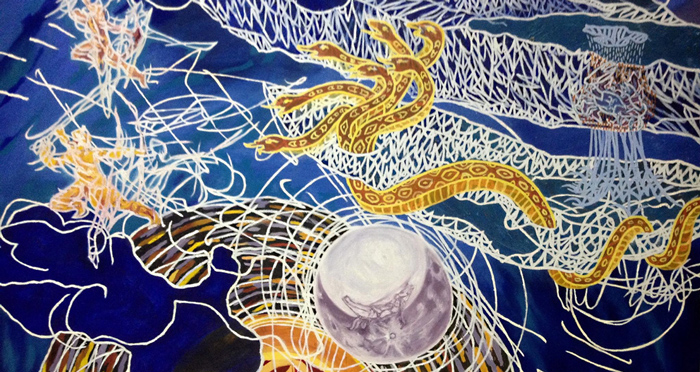 The sugidanon (epics) are long-chanted narratives that trace the journey of major characters, Labaw Donggon, Matan-ayon, Humadapnon, Malitong Yawa and other interesting characters in a maritime and country setting on the hinterlands of Panay Western Visayas, Central Philippines. The sugidanon reveals a wealth of information about the early Panaynon culture, the world view of these people, their environment, and the strong structure of the pre-colonial societies in the Visayas. The paper will retrace the beginnings of epic research in Panay Island and the description of the rigorous work experiences and tasks that went with it in terms of fieldwork until publication. Specifically, the ethnographic location traversed will be shown, the people met, the terrain, the fieldwork done, the recording, the transcription until its archiving, digitizing and publications. Thirteen (13) titles were gathered from 1993 to 1997. These are Tikum Kadlum (Enchanted Dog), Amburukay (Enchanted Hermit Woman), Derikaryong Pada (Gold Medallion), Kalampay (Enchanted Crab), Pahagunong, Sinagnayan, Balanakon, Humadapnon 1: Sa Tarangban (Cave), Humadapnon 2: Pagbalukat ka Biday (Recovering the Heirloom Boat), Humadapnon 3: Hungaw (The Wedding) Humadapnon 4: Ginlawan (The Customary Law on Death), Alayaw (Sweet-Scented Flower), and Nagbuhis (Ritual of Power Transfer). Just recently a fourteenth title was added that would cap the other 13 stories. These series recorded in its original archaic form were translated to the nearest Kinaray-a dialect, Filipino, and English. What is it now today – how it progressed, in terms of bringing it to the mainstream knowledge. Although surmountable, the task was met in terms of translation because the dinumaan or sinauna nga Kinaray-a language used in the epics had become archaic considering its structure its structure and vocabulary when translated in English – the international language – is different.
The sugidanon (epics) are long-chanted narratives that trace the journey of major characters, Labaw Donggon, Matan-ayon, Humadapnon, Malitong Yawa and other interesting characters in a maritime and country setting on the hinterlands of Panay Western Visayas, Central Philippines. The sugidanon reveals a wealth of information about the early Panaynon culture, the world view of these people, their environment, and the strong structure of the pre-colonial societies in the Visayas. The paper will retrace the beginnings of epic research in Panay Island and the description of the rigorous work experiences and tasks that went with it in terms of fieldwork until publication. Specifically, the ethnographic location traversed will be shown, the people met, the terrain, the fieldwork done, the recording, the transcription until its archiving, digitizing and publications. Thirteen (13) titles were gathered from 1993 to 1997. These are Tikum Kadlum (Enchanted Dog), Amburukay (Enchanted Hermit Woman), Derikaryong Pada (Gold Medallion), Kalampay (Enchanted Crab), Pahagunong, Sinagnayan, Balanakon, Humadapnon 1: Sa Tarangban (Cave), Humadapnon 2: Pagbalukat ka Biday (Recovering the Heirloom Boat), Humadapnon 3: Hungaw (The Wedding) Humadapnon 4: Ginlawan (The Customary Law on Death), Alayaw (Sweet-Scented Flower), and Nagbuhis (Ritual of Power Transfer). Just recently a fourteenth title was added that would cap the other 13 stories. These series recorded in its original archaic form were translated to the nearest Kinaray-a dialect, Filipino, and English. What is it now today – how it progressed, in terms of bringing it to the mainstream knowledge. Although surmountable, the task was met in terms of translation because the dinumaan or sinauna nga Kinaray-a language used in the epics had become archaic considering its structure its structure and vocabulary when translated in English – the international language – is different.
Liby Limoso
 Liby Limoso, born in Lambunao, Iloilo, is a visual artist and educator. His interests in local language, place, identity, memory and spirituality led him to work on documenting and visualizing the oral tradition of Panay mythology, making the oral visual and the absent present.
Liby Limoso, born in Lambunao, Iloilo, is a visual artist and educator. His interests in local language, place, identity, memory and spirituality led him to work on documenting and visualizing the oral tradition of Panay mythology, making the oral visual and the absent present.
He finished Bachelor of Fine Arts (Painting) at U.P. Diliman in 2001 and was a recipient of the Dominador Castañeda Best Thesis Award. In 2010 he graduated from the University of Pennsylvania, School of Design with a Certificate in Time Based and Interactive Media and a Master’s Degree in Fine Arts as a Ford Foundation International Fellow. His teaching experience include UP College of Fine Arts in Diliman and Central Philippine University, Digital Media and Interactive Arts in Iloilo. He was head of the University of San Agustin Iloilo, Fine Arts Program from 2014-2017.
Liby had participated in the Visayan Islands Visual Arts Exhibit Conference (VIVA ExCon) exhibitions in the past. He was represented in the exhibit Turns in Form curated by Patrick Flores for VIVA ExCon Iloilo 2016, and Conjunctions of Meaning and Place, curated by Green Papaya Art Projects for VIVA ExCon Capiz 2018. He is part of the curatorial team for Kalibutan: The World in Mind exhibit VIVA ExCon Bacolod 2020-21. They are working on a complementary project of cosplay and retablo to present characters from the world of Panay Island indigenous people’s mythology.
In 2019, he joined the International Society of Education Through Art 2019 World Congress at the University of British Columbia, Canada. He was an artist-in-residence at the University of Regina, Faculty of Media, Art & Performance and was a guest lecturer at the University of Manitoba, School of Art.
In 2020 he mounted Ang Darangan sa Sakayan nga Bulawan for the Dinagyang Arts Festival: Obra in Iloilo City. He is currently working on video documentaries about Babaylan tradition in Iloilo and full-length performances of current Sugidanun master chanters.
Meditations on Location
 Image has origin, a point of genesis or a place of birth. The first cave drawings, the earliest human acts of visual translations were also the phenomenal contextual beginnings of man’s social and environmental awareness. Human visual representation not only depicts the subject or its idea, it also embodies the circumstance that a visual deposition is a confluence of thought, time and space. The possibility of a created image is a product of perception, conceived in a distinct location, in a specific moment or era. Over the centuries, keenly perceived, well-thought and well-executed works have become the masterpieces representing period and place, and consequentially, country or nationality. Although the genius behind a great work can never be discounted, technical reference on location, and the time of creation are equally important elements of an artwork’s history that critically reinforces the academics of its archiving and magnifies its personal, social and even economic and political significance.
Image has origin, a point of genesis or a place of birth. The first cave drawings, the earliest human acts of visual translations were also the phenomenal contextual beginnings of man’s social and environmental awareness. Human visual representation not only depicts the subject or its idea, it also embodies the circumstance that a visual deposition is a confluence of thought, time and space. The possibility of a created image is a product of perception, conceived in a distinct location, in a specific moment or era. Over the centuries, keenly perceived, well-thought and well-executed works have become the masterpieces representing period and place, and consequentially, country or nationality. Although the genius behind a great work can never be discounted, technical reference on location, and the time of creation are equally important elements of an artwork’s history that critically reinforces the academics of its archiving and magnifies its personal, social and even economic and political significance.
From the invention and evolution of the geographic coordinate system, and the adoption of the Royal Observatory in Greenwich, England as the zero-reference for longitude, to the advancements and innovations that the Global Position System (GPS) has technologically produced, location and position as information, has never been as inextricable and invaluable in contemporary life, science or culture. Almost anything now can be GeoTagged.
This creative series explores the connection of image and its location. Vernacular scenes, plants, landscapes or objects are drawn with the specific geographic coordinate where it was derived or conceived. A visual fusion of imagery and its corresponding numerical coordinates in longitude and latitude, as a playful graphic exercise to retrace position, reorient declination and relocate the bearings of meanings.
Babbu Wenceslao
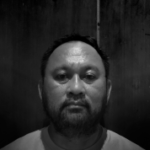
Babbu Wenceslao is a visual artist and musician based in Dumaguete City, in the island province of Negros Oriental in the Philippines. He was born in Tagbilaran City, Bohol on March 28, 1972, where he began his childhood education until his family moved to Cebu when he was seven. He continued his primary education in Cebu City but eventually finished elementary school in SPC, Ormoc City in the island of Leyte. He finished secondary school in SUHS in Dumaguete City, when the family moved to Negros Oriental. He went back to Cebu to pursue a degree in Painting at the University of the Philippines Cebu College. Currently, he teaches studio courses in theFoundation University’s Department of Architecture and Fine Arts and plays guitar and vocals for Istorya Isla, a Visayan band in Dumaguete. He also runs a bar, restaurant and alternative art space with wife, June Cleo Flores Wenceslao. They have three children, Felix Wynn, Wyanna Fiel, and Fynn Waquin.
ARTIST PROFILE
Babbu Wenceslao is an artist and musician based in the city of Dumaguete in the island province of Negros Oriental, located in the Visayas region of the Philippines. He finished his Bachelors in Painting from the University of the Philippines Cebu College in 1995. He has taught in Silliman University’s College of Performance and Fine Arts and has helped in establishing Foundation University’s Department of Architecture and Fine Arts where he currently teaches studio arts. In 2012, he organized the 12th VIVA ExCon (Visayas Islands Visual Arts Exhibition and Conference) in Dumaguete as project director. His creative works explores various aspects of culture, environment, events and geography and its critical connection and relationship with society and identity. He utilizes a wide range of materials in his artworks, from conventional to video, wood, steel, hardware 7 objects, fiberglass, terra cotta, and ceramics. In 2016, he released an album entitled “Seryoso Medyo” with Visayan rock band Istorya Isla, as main vocals and rhythm guitar. The album is a collection of twelve predominantly Cebuano tracks featuring a remake of an old Visayan reggae piece called “Baso” written in 1992 and a single entitled “Gabii,” which became one of the finale features for a local musical “Scharon Mani” staged in 2016 at the Luce Auditorium. His 2019 creative pursuits and collaborations include a group show exhibition entitled “Anonymous Animals” with fellow Dumaguete based artist mounted at the National Commission for Culture Arts’ main gallery in Manila. He also finished a three week artist residency at the University of Tasmania, Australia and participated in a collaborative ceramic installation with Filipino Artists Pablo Capati and Mark Valenzuela in the 2019 Australian Ceramic Triennale in Hobart, Tasmania. In August of the same year, he did a month long residency and group exhibition at the TU Collab Art Space in Singapore facilitated by Boxplot Project. He also established the first Artist Residency Program for Foundation University in Dumaguete City in October of 2019. His current series of works fuse and integrate image and geographical location as a visual exercise to reiterate a strong reference to the relationship or notion of object and place and its multifaceted meanings.
Dances from the Heartlands: Illustrated Re-presentations of Folk Dances from the Visayas
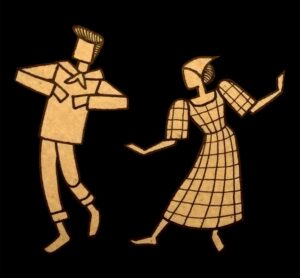 In the early 2000s, the proponent of the exhibit began researching on Philippine folk dances, with the keen interest of a visual artist. Recently, in preparation for a paper presentation, he once again deemed the Visayas region underrepresented in the repertoire of traditional dance concerts and chapters of related literature. Titles of collections of folk dances seem to reveal a dearth of substantial feature on the Philippine heartlands. Common are headings such as, “the Cordilleran Suite,” pertaining to dances of the North Luzon Igorots; “the Maria Clara Suite,” about Spanish-influenced dances; “the Moro/Mindanao Suite”, featuring the dances of largely Muslim groups in Mindanao; and “the Rural Suite”, an apparent catch-all term for secular, provincial dances.
In the early 2000s, the proponent of the exhibit began researching on Philippine folk dances, with the keen interest of a visual artist. Recently, in preparation for a paper presentation, he once again deemed the Visayas region underrepresented in the repertoire of traditional dance concerts and chapters of related literature. Titles of collections of folk dances seem to reveal a dearth of substantial feature on the Philippine heartlands. Common are headings such as, “the Cordilleran Suite,” pertaining to dances of the North Luzon Igorots; “the Maria Clara Suite,” about Spanish-influenced dances; “the Moro/Mindanao Suite”, featuring the dances of largely Muslim groups in Mindanao; and “the Rural Suite”, an apparent catch-all term for secular, provincial dances.
While Tinikling and Cariñosa are known Visayan dances, the titles of the collection in which they are included do not highlight this fact. It is worth noting that there are more, albeit less known, folk dances from this region that could share the spotlight and be presented to a wider audience. As examples of intangible heritage, these folk dances reveal how multi-faceted the Filipino identity is, with geography bringing nuances to the rich diversity.
Through a collection of papercut illustrations depicting various Visayan folk dances, the artist intends to shine a light on the Philippine heartlands, as cradles of these particular artistic expressions. By presenting illustrated tableaus of known and less-known Visayan dances, the artist hopes to encourage informed and insightful conversations about these living traditions. As illustrations, these can be scanned and used in support of educational materials.
Joseph Andrew “Jandy” A. Carvajal
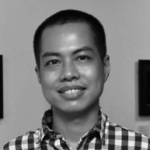 Joseph Andrew “Jandy” A. Carvajal is Assistant Professor of Fine Arts at the University of the Philippines Baguio. Alongside teaching, he continues his art practice, working with various media, from graphite to metal sheets. His pieces have been exhibited in Manila, Baguio, London and New York. In 2016, he earned his MFA in Studio Art degree from Montclair State University, NJ on a Fulbright scholarship. Photos of his works may be viewed on jandycarvajal.com.
Joseph Andrew “Jandy” A. Carvajal is Assistant Professor of Fine Arts at the University of the Philippines Baguio. Alongside teaching, he continues his art practice, working with various media, from graphite to metal sheets. His pieces have been exhibited in Manila, Baguio, London and New York. In 2016, he earned his MFA in Studio Art degree from Montclair State University, NJ on a Fulbright scholarship. Photos of his works may be viewed on jandycarvajal.com.
Ang Unang Balak ni Antonio Pigafetta
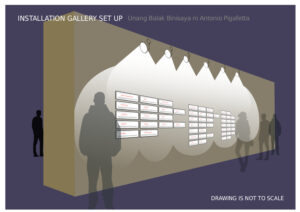 In the beginning was the word proclaims St. John the Evangelist. This beginning, for many of us, is located at the moment of ‘discovery’ of our islands by Ferdinand Magellan, his crew, and not far behind, the Spanish colonial project.
In the beginning was the word proclaims St. John the Evangelist. This beginning, for many of us, is located at the moment of ‘discovery’ of our islands by Ferdinand Magellan, his crew, and not far behind, the Spanish colonial project.
Yet, this beginning surely had a much earlier beginning, as evidenced by the lexicograph compiled by Antonio Pigafetta. These words, when and where originally recorded, were everyday words but also likely to be poetry or song as attested to by those who followed after the initial contact. Pigafetta, then, was unknowingly writing down poetry or recording its germinal ingredients. This work, then, appropriates Pigafetta, recasting the arguably innocent effort of note-taking (or data-gathering) into the more purposive project of poetry writing with a decidedly dadaist, automatist twist.
Since many of these words are still in use today and with a slew of schizophrenia-inducing linguistic influences from all over – especially with call-centers continuing to be a growth industry – this project can be said to be a work in progress, fully cognizant, concomittantly, that for the most part progress in whatever form is accompanied, even facilitated, by backward glances or more determinedly by appeals to history.
RoyLu.
 RoyLu studied painting at the University of the Philippines, College Cebu (UPCC), where in 1978, along with co-students, he organized the MindWorks, an exhibit and art event featuring works that were then outside the Fine Arts program’s curriculum. This would become a yearly feature of the program and soon after, with the addition of the performance art component, its most celebrated if often controversial attraction. MindWorks has had an uninterrupted run until the pandemic’s rude disruption of the academic schedule. Together with other UPCC Fine Arts alumni, he established the Lunâ Art Collective, setting up a self-financed art workshop and exhibit space; the first ever in Cebu City. Soon after his migration to Québec, Canada, in 2007, his involvement with the local performance art group Fait Maison led to his being a recipient of the Dennis Tourbin Fund for Emerging Artists. While performance art is his focus, he also does installations and other object-based art which have been exhibited in local galleries and artist-run spaces. He notably performed in Art en direct: Art en ruines, a collaboration between Galerie Nouvel Ontario, Debajehmujig Storytellers and 4elements Living arts in Wiikwemkoong unceded territory, the largest Anishnaabek community on Manitoulin Island; during the FAAS4: Festival of alternative art in Sudbury, Ontario; the 2014 Rencontre Internationale d’Art Performance, in Québec and three other cities (also co-curating the Philippine participation in this biennale); and in the 2016 Cimiento : Festival de performance y Accionismo, in Cochabamba, Bolivia. Audience participation is an integral and critical element of his works, offering an opportunity to interrogate the intersection of history, culture and identity.
RoyLu studied painting at the University of the Philippines, College Cebu (UPCC), where in 1978, along with co-students, he organized the MindWorks, an exhibit and art event featuring works that were then outside the Fine Arts program’s curriculum. This would become a yearly feature of the program and soon after, with the addition of the performance art component, its most celebrated if often controversial attraction. MindWorks has had an uninterrupted run until the pandemic’s rude disruption of the academic schedule. Together with other UPCC Fine Arts alumni, he established the Lunâ Art Collective, setting up a self-financed art workshop and exhibit space; the first ever in Cebu City. Soon after his migration to Québec, Canada, in 2007, his involvement with the local performance art group Fait Maison led to his being a recipient of the Dennis Tourbin Fund for Emerging Artists. While performance art is his focus, he also does installations and other object-based art which have been exhibited in local galleries and artist-run spaces. He notably performed in Art en direct: Art en ruines, a collaboration between Galerie Nouvel Ontario, Debajehmujig Storytellers and 4elements Living arts in Wiikwemkoong unceded territory, the largest Anishnaabek community on Manitoulin Island; during the FAAS4: Festival of alternative art in Sudbury, Ontario; the 2014 Rencontre Internationale d’Art Performance, in Québec and three other cities (also co-curating the Philippine participation in this biennale); and in the 2016 Cimiento : Festival de performance y Accionismo, in Cochabamba, Bolivia. Audience participation is an integral and critical element of his works, offering an opportunity to interrogate the intersection of history, culture and identity.
The Chaleco/Kimona with eight tiesAn anamnesis of a childhood spent in a Visayas-based cult
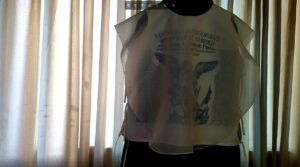 The chaleco, Spanish for vest, is a significant object in the discussion of Philippine charms, talismans, amulets and fetishes. The most famous of which is Macario Sakay’s, currently in the holdings of the US National Archives. Having been raised within a Visayas-based cult’s belief system where an amalgam of spiritism, authoritative divine power, and sacrifice exist; I received my chaleco when I was around 11 years old, and promptly lost it a month later.
The chaleco, Spanish for vest, is a significant object in the discussion of Philippine charms, talismans, amulets and fetishes. The most famous of which is Macario Sakay’s, currently in the holdings of the US National Archives. Having been raised within a Visayas-based cult’s belief system where an amalgam of spiritism, authoritative divine power, and sacrifice exist; I received my chaleco when I was around 11 years old, and promptly lost it a month later.
After 35 years, I am still making sense of my childhood experiences within the cult. To this end, and for the first time, I am confronting these experiences using the chaleco. I do this through a mixed media installation with the chaleco as armature, serving as documentation and presentation of this confrontation. Using actual items when accessible or recreating approximate objects used by the cult, modifying them and incorporating them on the chaleco, the chaleco now becomes both a reification and catalyzing object. Creating a narrative of a particular childhood within the cult. This paper and subsequent presentation would be an exegisis of this process.
Riza Romero
 Riza Romero is a multidisciplinary cultural worker, researcher and educator who grew up in Cagayan de Oro City, Misamis Oriental from Visayan parents from Cebu and Antique. She completed her degree in Bachelor of Fine Arts (Painting) and Bachelor of Science in Social Work from the University of the Philippines Diliman. In 2013, she completed her Master of Arts in Design (Media and Interaction Design) from the National Cheng Kung University (國立成功大學), Taiwan ROC. She is currently an assistant professor in the University of the Philippines, Diliman, teaching and mentoring at the Department of Studio Arts and the Graduate Program of the College of Fine Arts.
Riza Romero is a multidisciplinary cultural worker, researcher and educator who grew up in Cagayan de Oro City, Misamis Oriental from Visayan parents from Cebu and Antique. She completed her degree in Bachelor of Fine Arts (Painting) and Bachelor of Science in Social Work from the University of the Philippines Diliman. In 2013, she completed her Master of Arts in Design (Media and Interaction Design) from the National Cheng Kung University (國立成功大學), Taiwan ROC. She is currently an assistant professor in the University of the Philippines, Diliman, teaching and mentoring at the Department of Studio Arts and the Graduate Program of the College of Fine Arts.
Through her cultural work, she is exploring the context, development and implications of mediated and mediating stories. This manifests in her works included in the group exhibitions Unravelling Bettina: What Makes a Story a Story? (Arte Bettina, October 2019), Ars Longa, Vita Brevis (The SSS Gallery, September 2018), Manifold Reflections (Art Anton, September 2017); in the designs she created for the theater productions Miracle in Hello (2019), Buwan at Baril sa E♭ Major (2017) – Best Non-Musical Production to the Aliw Awards 2017 nominee; and, film productions Hinabing Pakpak ng Ating mga Anak (2016), and Para sa Hopeless Romantic (2015) – FAMAS Awards 2016 Best Production Design nominee.
“When it Rains, It Pours”
Mixed Media, 2019
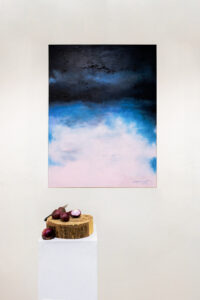 “When it Rains, It Pours” rearticulates personal narratives to show a desire to negotiate my commitment to women’s welfare. The artwork shows a juxtaposition of objects associated with homemaking. The painting of vast murky skies, illustrates the continuing contestations against normative behaviors and conventions inscribed quite durably in culture.
“When it Rains, It Pours” rearticulates personal narratives to show a desire to negotiate my commitment to women’s welfare. The artwork shows a juxtaposition of objects associated with homemaking. The painting of vast murky skies, illustrates the continuing contestations against normative behaviors and conventions inscribed quite durably in culture.
Palmy Pe – Tudtud

Closing Performances
Mangayaw
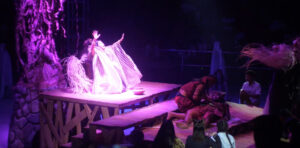
MANGAYAW “Performing The World of Our Ancestors” is a presentation based on a 2019 Theater Production, unravelling icons, systems and practices of Pre-Colonial Visayas and establishing the integrity and depth of wisdom of Filipino ancestors.
Performed last December 14, 2019 in Lapulapu City and produced by the National Historical Commission of the Philippines (NHCP), MANGAYAW signaled the launching first day of the 500-days Countdown prior to the Victory at Mactan Celebrations in 2021. The production engaged about 300 performers from different cultural groups from the Visayas Over all artistic direction was by theater director Lutgardo Gardy Labad in collaboration with a pan-Visayan team of leading theater leaders and directors:
Four Visayan High School students on a research on their Visayan Pre-Hispanic World dramatize their discovery of : (a) Myths of Origin of the Visayas; (b) The Social Systems of Visayan Societies prior to Spanish Contact; (c) Significant Cultural Components of the Age: Local and International Trading, Pangayaw, Internecine Wars and Raids, Patik (Tatoos), Binukot (Special Women), Sandugo (Blood Compact); (d) Examples of Cultural Craftsmanship, Animist Spirituality and (g) Governance and Heroism. To ensure that the MANGAYAW production is anchored in historical and cultural authenticity, collaboration with Visayan history and culture scholars was effected: Dr. Vicente Villan, Dr. Earl Jude Cleope, Dr. Jobers Bersales, Dr. Ronald Borrinaga, Marianito Luspo and Jay Jore.
Mr. Labad is currently mounting a Boholano version of this production as part of the Unveiling of a Historical Marker by the NHCP in cooperation with the Provincial Government of Bohol in Maribojoc, Bohol, on May 2, 2021. This marker commemorates the passage of one of Magellan’s ships in 1521 across Maribojoc Bay. A special edited recording of this show will be the team’s entry to the SOAS Conference in June 2021.
Lutgardo Labad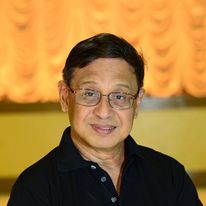 Gardy is a Boholano theater director, musical composer, and a cultural development specialist. He was instrumental in the development of the theater aesthetics and curriculum of the Philippine Educational Theater Association or PETA, from 1973-1994. He is the International Staging Director and Impresario of the world-famous Loboc Children’s Choir
Gardy is a Boholano theater director, musical composer, and a cultural development specialist. He was instrumental in the development of the theater aesthetics and curriculum of the Philippine Educational Theater Association or PETA, from 1973-1994. He is the International Staging Director and Impresario of the world-famous Loboc Children’s Choir
He composed about 85 films for which he received awards for Best Film Score and organized about 15 culture festivals in the country and directed about 30 theater productions across the country and abroad. In 2010 he was named Best Director by the ALIW AWARDS for a Non-Musical Production for his work on PETA’s ANG POST OFFICE. He founded the Bohol theater company KASING SINING TEATRO BOL-ANON Ensemble (1997, 2014) and led many programs in heritage protection and revitalization especially for the province. Gardy was Head of the NCCA Committee on Dramatic Arts twice and was a recipient of the Asian Public Intellectual Fellowship Award of the Nippon Foundation in 2011.
At present he is the Artistic Creative and Pedagogy Director of trailblazing projects for the Visayas region: the BACH Institute for Living Traditions, the Region VII Regional Cultural Hub, Cultural Mapping Project and SOUL OF PLACE a series of MTVs celebrating the 40th Anniversary of the Loboc Children’s Choir.
He was honored with the Fr. Francisco Demetrio Heritage Award by ATENEO DE CAGAYAN Xavier University in 2014, a Lifetime Achievement Award in Theater by PHILSTAGE last May 2019, and the GLORY AWARD 2020 by the UP CMCAA (College of Mass Communication Alumni Association) for Arts and Culture Advocacy.
xo?@XOAS
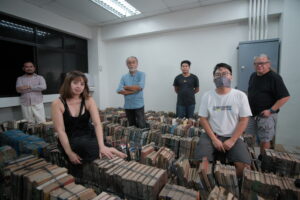 “xo?” is a performance art group with an open membership. It began when Russ Ligtas and Chai Fonacier recuited Raymund L. Fernandez to do a series of shows in various drinking spots here in Cebu including Kukok’s Nest, Turtle’s Nest, The Outpost, Luńa Art Space, Expose, and others. Exposé was somewhat different in that it was a hair salon which turned into a bar in the evening. The owner welcomed us to do a show there every week. And we did so with a bigger group that now included Winston Velez and Oliver Seville, both deceased; Javy Villacin, Fred del Mar and Nino Baring, as well as Roylu, Greys Compuesto and Liyo de Norte. xo? began in Cebu in the mid-2000s. Some of its members are now based in other places. This will be the first time the group is presenting online.
“xo?” is a performance art group with an open membership. It began when Russ Ligtas and Chai Fonacier recuited Raymund L. Fernandez to do a series of shows in various drinking spots here in Cebu including Kukok’s Nest, Turtle’s Nest, The Outpost, Luńa Art Space, Expose, and others. Exposé was somewhat different in that it was a hair salon which turned into a bar in the evening. The owner welcomed us to do a show there every week. And we did so with a bigger group that now included Winston Velez and Oliver Seville, both deceased; Javy Villacin, Fred del Mar and Nino Baring, as well as Roylu, Greys Compuesto and Liyo de Norte. xo? began in Cebu in the mid-2000s. Some of its members are now based in other places. This will be the first time the group is presenting online.
XO Profile
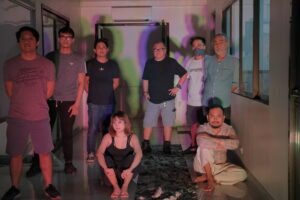 For this show the following are performing: Roylu, Russ Ligtas, Greys Compuesto, Javy Villacin, Fidel Ricafranca, Gani and Raymund Fernandez, Jovi Juan, with Jimmy Timkang helping with the technicals. So this show would be something of a reunion. The xo? shows always had a very loose structure and few definite rules. One is that the show had to begin at the appointed time with anyone who was there performing. Anybody who was there, the audience, could join in and they often did. Quite a number of local poets, including Bambi Beltran, Anthony Kintanar, and the late Ana Neri read their works or the works of others. The idea was to break, pierce or blur the barrier between performer and audience. This worked with a live audience. Will it work for “xo@XOAS,” the title we have given this show? We shall xee.
For this show the following are performing: Roylu, Russ Ligtas, Greys Compuesto, Javy Villacin, Fidel Ricafranca, Gani and Raymund Fernandez, Jovi Juan, with Jimmy Timkang helping with the technicals. So this show would be something of a reunion. The xo? shows always had a very loose structure and few definite rules. One is that the show had to begin at the appointed time with anyone who was there performing. Anybody who was there, the audience, could join in and they often did. Quite a number of local poets, including Bambi Beltran, Anthony Kintanar, and the late Ana Neri read their works or the works of others. The idea was to break, pierce or blur the barrier between performer and audience. This worked with a live audience. Will it work for “xo@XOAS,” the title we have given this show? We shall xee.